For one raised and used to living in cooler, moister climes, living in Sydney can bring on ‘conifer-depletion syndrome’.
The city’s warm temperate climate narrows the range that are comfortable and healthy to: natives Araucaria, Callitris and Podocarpus, exotics Afrocarpus, Cephalotaxus, some Asian cultivars of Chamaecyparis and Retinosperma (Thuja), the odd true cedar (Cedrus). It’s just too warm and humid, perhaps?
Sydney Botanic Garden’s renowned Palm Grove (planted from 1862 under Charles Moore) harbours a few intriguing non-palm trees, including a whopping and quite rare Asian conifer, the foothills keteleeria, K.fortunei.
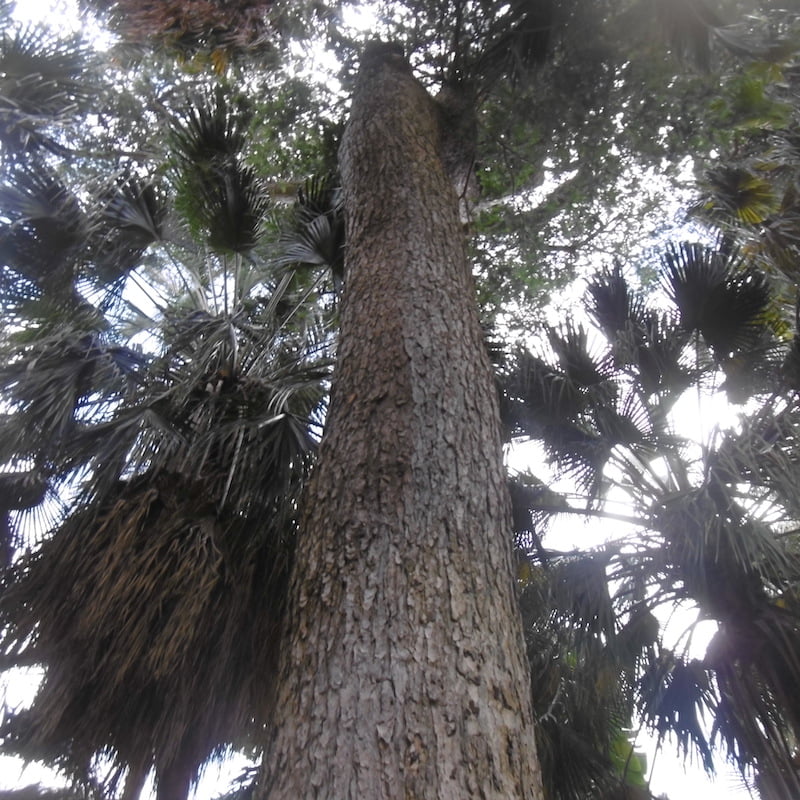
Palm Grove, Sydney Botanic Garden
In fact, this garden has three such specimens: one on the western side of the Hong Kong Shanghai Bank’s Oriental Garden north of the café, and on a lawn south of Government House – all mature and coning. They have large and interesting cones, which are bluish-green, tinged purple when young, papery to the touch, not stiff like pines. Like true firs (Abies), cones stick up, don’t hang down like spruces (Picea).
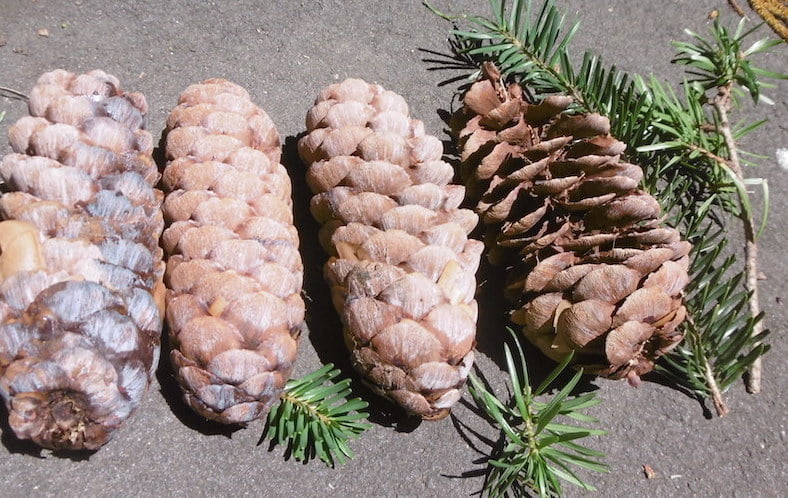
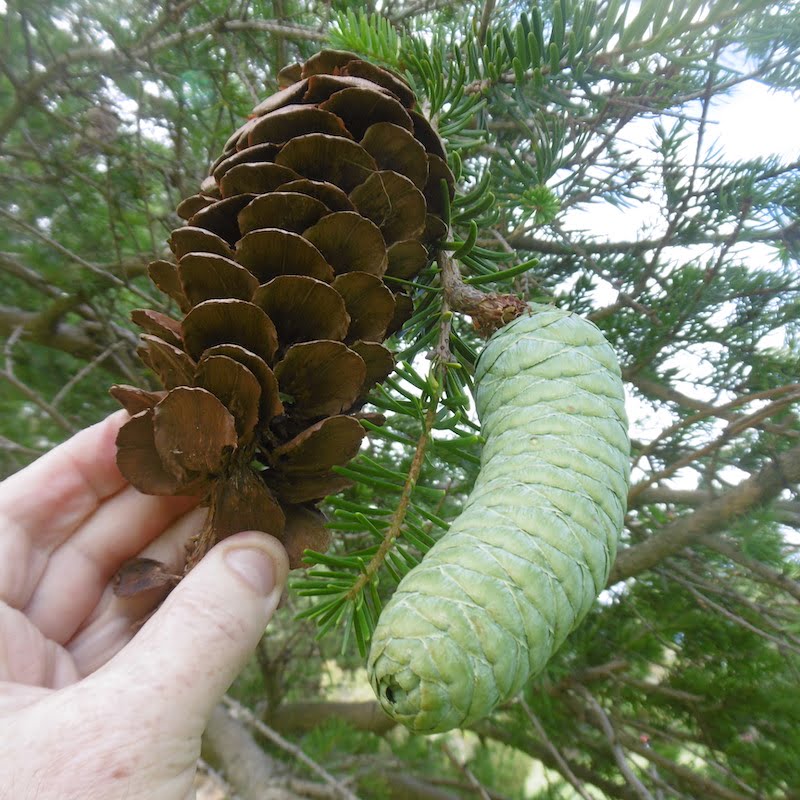
They also persist, intact, not shattering like fir cones, nor like the otherwise closely-related golden larch (Pseudolarix amabilis). Keteleeria trees have long, wide and softish flat ‘needles’ that look more like giant yews or plum yews (Cephalotaxus) than needles of other conifers. They have lovely bark. It’s corrugated, flaky, gingery when young, a bit like some rough-barked Angophora species.
Conifer expert James Eckenwalder notes that K.fortunei is rare in the wild, uncommon in cultivation, although more common than K.davidiana in Australia.
These rare, ‘common’ keteleerias look reasonably happy in Sydney’s warm, sticky summers and mild winters – unbothered. I note Melbourne Botanic Garden has a large old K.fortunei and a specimen of long-leaved K.evelyniana (in the pinetum near Government House, the only one I’ve seen in Australia).
I note the penchant of white cockatoos and eastern little corellas for ripping open bunya pine cones for their large, edible nuts and have seen the same with cones of Himalayan chir pines (Pinus roxburghii) – picked apart or shredded for their seeds, which are much like Keteleeria seeds in form. Given that flocks of corellas are, with sporadic droughts, becoming semi-permanent phenomena in Sydney, one wonders if there’s much hope of intact cones with seeds here? Some recent fossicking in the Palm Grove proved not so. I found handfuls of seed, untouched.
A great surprise
Imagine my delight and surprise, to boost that modest tally of four known Australian Keteleeria trees to six over a mere few days’ touring in New South Wales’ Southern Highlands, courtesy of the marvellous conference and tour of the Australian Garden History Society, in Mittagong.
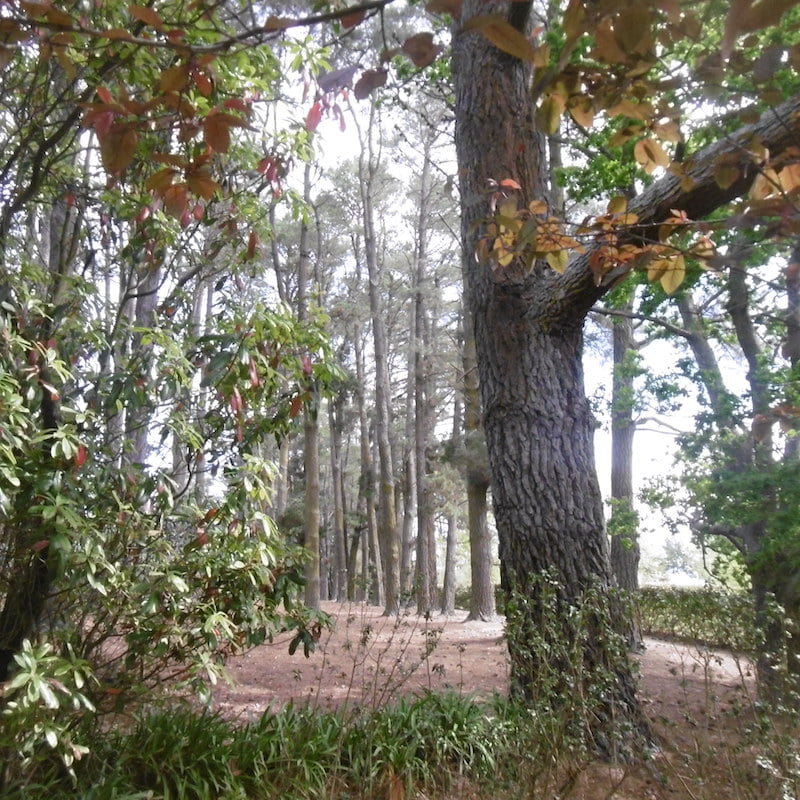
Keteleeria trunk at Rotherwood Garden
Visiting district garden ‘Rotherwood’, at Sutton Forest, brought a younger Keteleeria up its long, long drive, among a woodland near the house. Clearly coning, I collected two, which were much shorter in dimension than the Sydney trees’ cones: the former 5cm tall; the latter up to 8cm. That might mean they’re K.davidiana, rather than K.fortunei – I’ve not had the chance to check this out properly. It might mean they’re just getting less water and have more competition from nearby trees.
Not far away in Burradoo, ‘Southdown’s’ carriage loop and shrubbery, near the house, has a smaller Keteleeria, not, it seems, coning, being somewhat shrouded by other trees.
What are Keteleerias?
They’re Asiatic evergreen conifers named for French nurseryman, J.B. (Jean Baptiste) Keteleer (1803-1903), and there are now three accepted species from Southern China including Hainan, Taiwan, Korea and South East Asia (Northern Laos, Southern Vietnam): K.davidiana; K.fortunei and K.evelyniana. David Mabberley’s The Plant Book notes that North America and Northern Europe both have tertiary/Miocene fossils of this genus. So, it once had these trees too.
Often species and generic names can tell us some of the history of the plant’s discovery or at least its introduction into western horticulture and gardens. This is a good case of that.
Common Keteleeria (Ta/Tee Jian Shan) K.davidiana is named for Pere /Abbe Amand David (1826-1900), a French Catholic missionary and naturalist who collected the type (first-published) specimen. David collected some 1400 ‘new’ Chinese plants and many bare his name, e.g. Acer davidii, Davidia involucrata. This species is the only one hardy in England, but its champion tree is still only 11m tall.
The word ‘shan’ in Chinese means ‘hard iron’, a reference to its timber, the strongest softwood in much of Southern China, much-used for construction and carpentry. It is also one of the few conifers that will re-sprout new branches (future trunks) from the main trunk, once harvested. Subspecies K.davidiana ssp. davidiana (syn. F.d. var. formosana) is endemic to Taiwan and endangered.
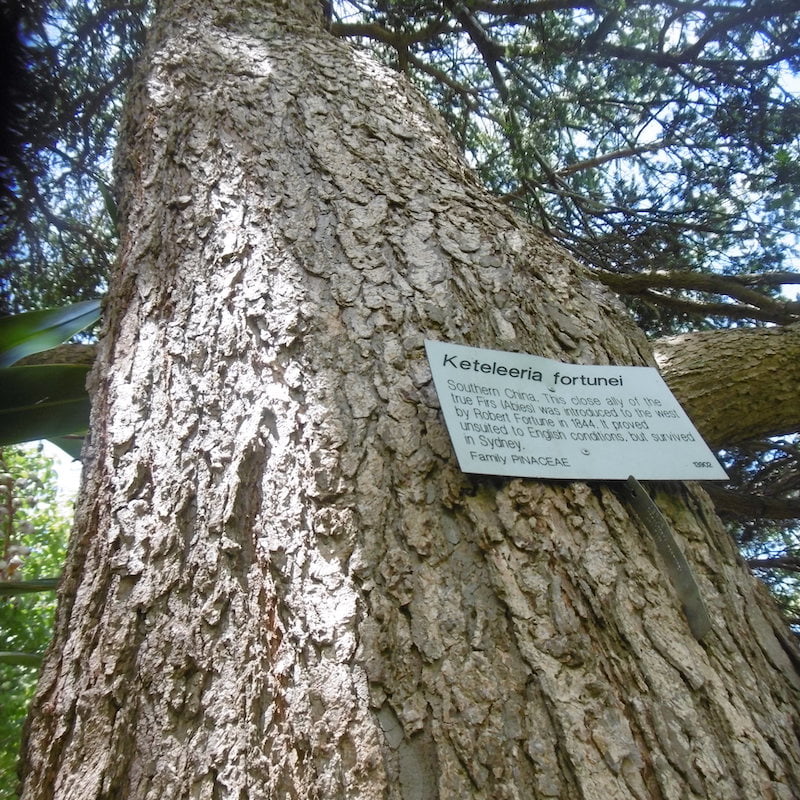
Oriental Garden, Sydney Botanic Garden. The correct introduction date should say 1849.
The foothills keteleeria (You Shan), K.fortunei is named for Robert Fortune, a Scottish plant hunter employed by the then Horticultural Society of London (now the Royal Horticultural Society). See my review of Alistair Watt’s fine 2017 biography of him here.
Eckenwalder notes that it’s the high oil content in the timber, which gives it its Chinese name ‘oil’ (shan) and makes it waterproof, thus its timber is important in ship-building. Irish plant hunter Seamus O’Brien notes a huge 35m x 7.3m girth trunked specimen in Tianzhuqiao Nature Reserve (part of Shennongujia Biosphere Reserve) in Hubei province (in the Three Gorges region), estimated to be 1200 years old. Quite a sight! He adds that plant hunter Augustine Henry introduced this species into cultivation through RBG Kew in 1888.
Long-leafed keteleeria (Yun Nan You Shan), K.evelyniana – is from China (particularly Western Yunnan), Laos and also Vietnam’s mountains, in tropical zones. It is also one of the most-southerly occurring Old World members of the true pine family, Pinaceae.
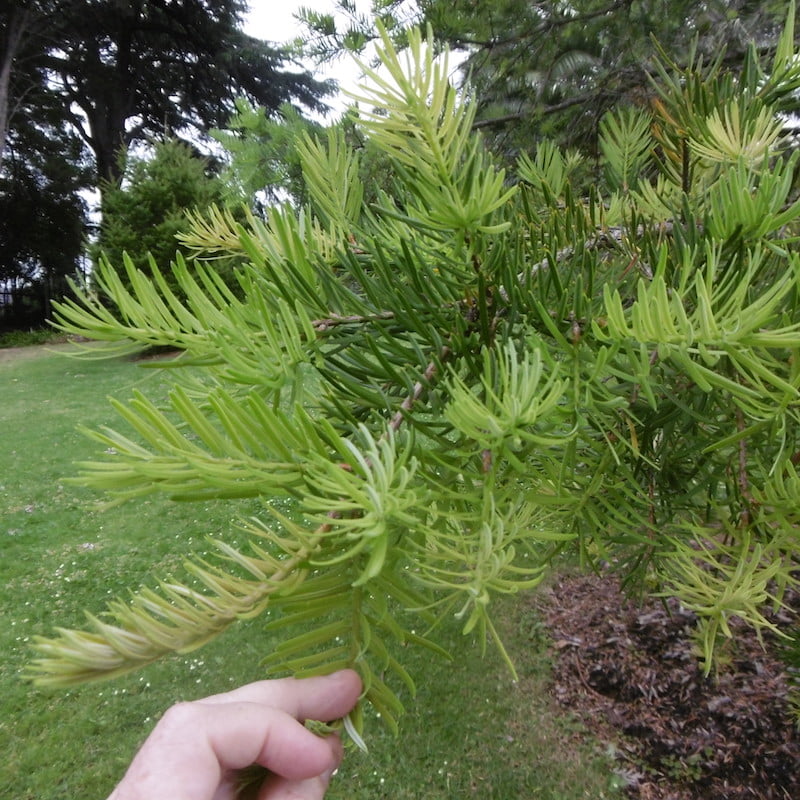
Keteleeria evelyniana RBG Melbourne
Robert Fortune found K.fortunei in Gushan (‘Koo-shan’ he called it) near Fuzhou on a visit in 1849, where he obtained seeds and specimens from a ‘noble’ conifer in a temple near the mountain’s summit.
Many books erroneously cite an 1844 introduction date (as do Sydney Botanic Gardens’ labels on their trees) on Fortune’s first Chinese expedition, a date disproven in Watt’s biography. Nursery Standish & Co. first got seed from Fortune, one of Watts’ pieces of evidence – Fortune’s first expedition in 1844 had to deliver all its ‘finds’ to LHS members, not to commercial nurseries…
Alistair Watt notes how LHS guru John Lindley erroneously named the first specimens Fortune sent him in 1850 as Abies jezoensis (which is Ezo spruce, from Japan). Botanist Murray corrected that in 1862, noting the specimen was new and from China, renaming it Picea fortunei. It was transferred into a new genus as Keteleeria fortunei by Carriere in 1866, published in Revue Horticole, honouring its discoverer.
Standish & Noble were advertising seedlings for sale in 1852. No tree survived in England. It was too cold. On the continent it fared better, in milder situations. Grimshaw and Bayton (2009) note it has never been a satisfactory genus in maritime Europe, needing hot summers and no late spring frosts to thrive. Mediterranean summer-dry climates seem to suit it better. Which again hints that it may be suitable for parts of Australia with such climates.
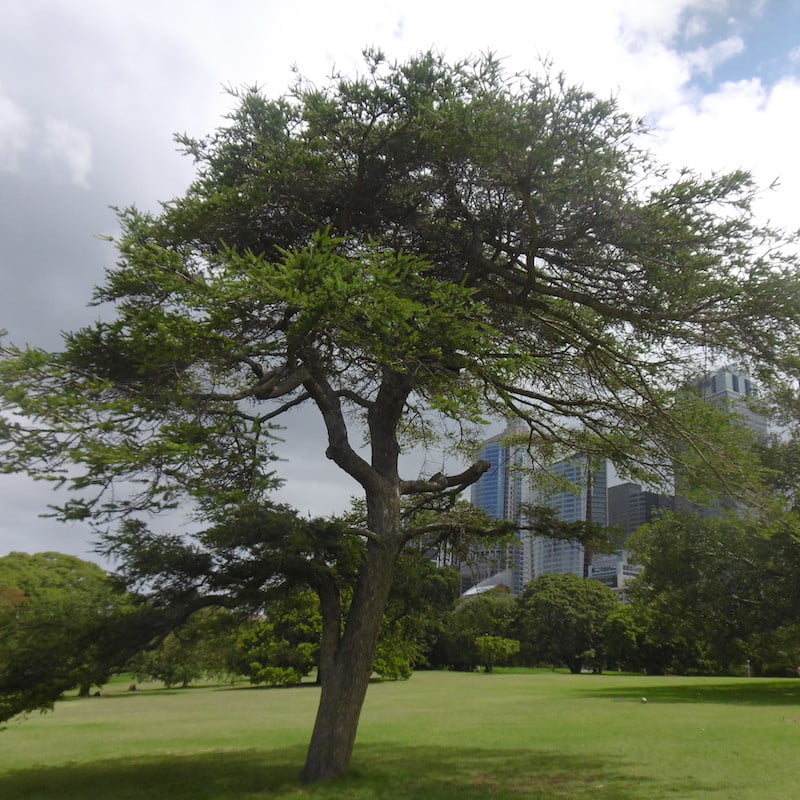
Near Government House, Sydney
Historian Colleen Morris (2018) notes one of Sydney Botanic Garden’s 19th century Keteleeria trees was the source of reintroduction into Britain in the early 20th century. She notes photographic evidence suggest it (I’d suggest the Palm Grove one) was probably planted in the 1860s. She adds that it was not correctly named until Joseph Maiden’s 1903 Guide to the Botanic Gardens, Sydney. Pleasingly, Keteleeria fortunei was chosen to include in the 2018 Florilegium Society’s book celebrating 200 years of our oldest Botanic Garden, in a painting by artist Linda Catchlove.
I’ve been wondering about their date(s) of introduction. It would have to be after 1860, which is the cut-off for Sydney Living Museums’ Colonial Plants Database; and Hortus Camdenensis. These both focus on what was growing in, or for sale in the colony prior to 1860. Given the palm grove tree’s trunk is at least a metre in diameter, its sister tree is only slightly less in girth, they look to me at something like 120-150 years old. Putting them squarely into Charles Moore’s tenure, as Director.
Of further intrigue to me is on how they got up three drives in the Southern Highlands and Tablelands? My guess is the owners of those estates either knew, or had dealt directly with Charles Moore to get one. It seems unlikely to have been in a Sydney nursery catalogue of the day (although Picea jezoensis was listed by Michael Guilfoyle & Sons’ Exotic Nursery, Double Bay in 1866. Was that a true fir, or the mis-named Keteleeria, yet to be renamed by M.Carriere? We’ll never be sure, but it seems unlikely, given the Botanic Garden’s trees were misnamed until 1903.
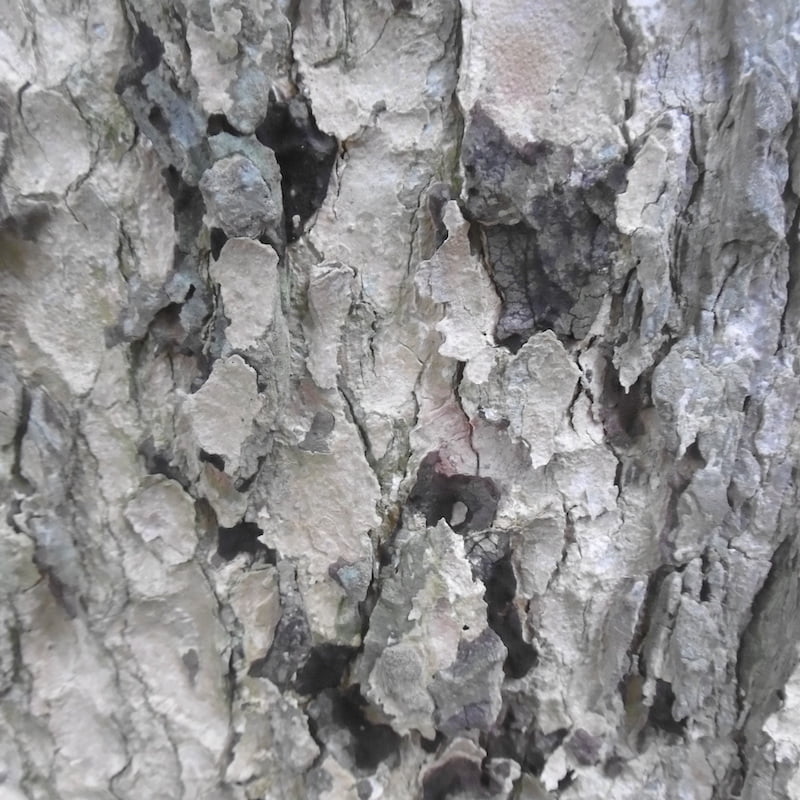
Corky bark
K.fortunei is a protected species in China. It is an evergreen conifer growing up to 25m high, with straight trunks, corky bark, furrowed in a vertical pattern and the branches distinctively horizontal and spreading. Branchlets are orange-red and hairy. Leaves are linear and stiff, with shiny tips. Female cones are cylindrical, 10-18cm long, purple or brownish when ripe (lime-green/blue when unripe), holding pairs of glossy brown-winged seeds in each cone scale.
This tree will grow from seed and cuttings and grows in drier and warmer climates than Abies, the fir (or Picea, the spruce).
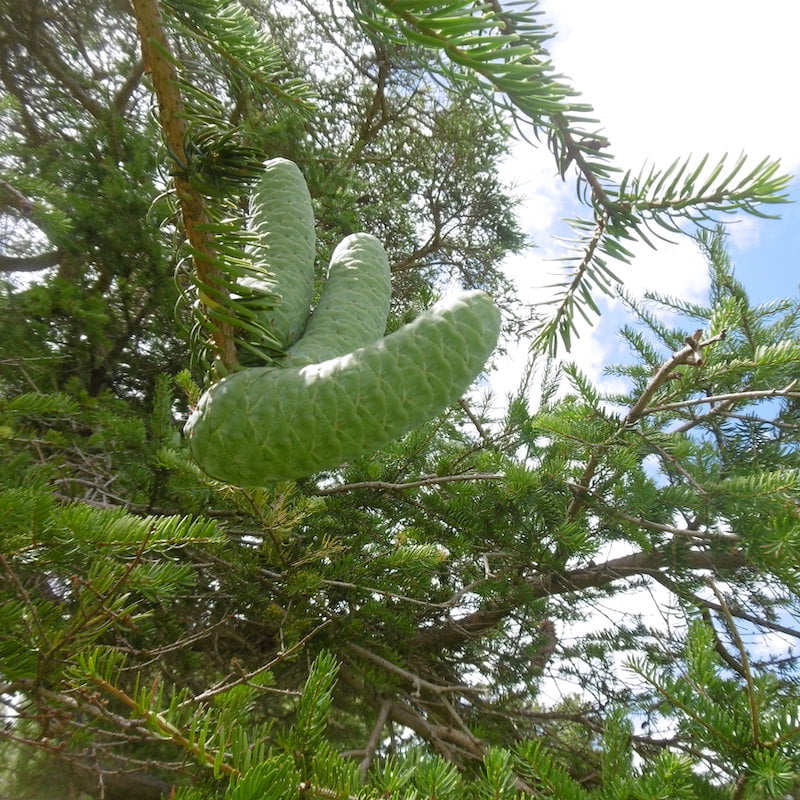
Bluish cones
Alistair Watt laments it is not more-widely grown, with its handsome form, bluish cones and hardiness. He rates it as one of Fortune’s three great conifer introductions (along with Pseudolarix amabilis (Japanese golden larch) and Torreya grandis (nutmeg yew). I agree. It’s a fine tree, which seems worth trials and wider use, in larger gardens, parks and even forestry plots. To say nothing of its sister species, which is well worth seeking out and trying, from seed or cuttings.
Sources:
Eckenwalder, James, 2009, Conifers of the World – the complete reference, Timber Press;
Grimshaw, John & Bayton, Ross, 2009, New Trees – recent introductions to cultivation, Kew Publishing, Royal Botanic Gardens, Kew, in association with (commissioned and produced by) the International Dendrology Society;
Mabberley, David, 2017, Mabberley’s Plant Book – a portable dictionary of plants, their classifications and uses, 4th edition, Cambridge University Press
Morris, Colleen and Murray, Louisa, 2018, The Florilegium – The Royal Botanic Gardens Sydney – celebrating 200 years – plants of the three gardens of the Royal Botanic Gardens and Domain Trust, The Florilegium Society at the Royal Botanic Gardens, Sydney;
O’Brien, Seamus, 2011, In the footsteps of Augustine Henry and his Chinese plant introductions, Garden Art Press;
Watt, Alistair, 2017, Robert Fortune, a plant hunter in the Orient, Kew Publishing, Royal Botanic Gardens, Kew
